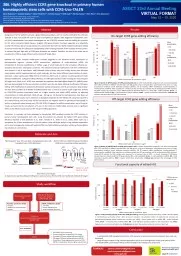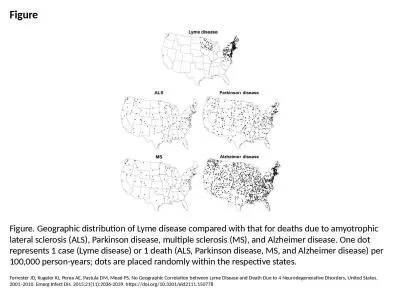PPT-Does a knockout of NDUFA2 Lead to Parkinson’s Disease?
Author : myesha-ticknor | Published Date : 2018-03-12
Ruairidh Barlow What is Parkinsons Disease Age related neurodegenerative disease Symptoms tremors stiffness and slow movement Substantia Nigra Pars Compacta Death
Presentation Embed Code
Download Presentation
Download Presentation The PPT/PDF document "Does a knockout of NDUFA2 Lead to Parkin..." is the property of its rightful owner. Permission is granted to download and print the materials on this website for personal, non-commercial use only, and to display it on your personal computer provided you do not modify the materials and that you retain all copyright notices contained in the materials. By downloading content from our website, you accept the terms of this agreement.
Does a knockout of NDUFA2 Lead to Parkinson’s Disease?: Transcript
Ruairidh Barlow What is Parkinsons Disease Age related neurodegenerative disease Symptoms tremors stiffness and slow movement Substantia Nigra Pars Compacta Death of dopaminergic neurons is a key feature in the pathology of the disease. Spiderman Bearings. Spidey is on the lookout for criminals.. Can you help him by giving him the three figure bearing for each on the grid?. N. Juggernaut. Ox. Dr Octopus. Rhino. Carnage. Venom. Shriek. PHAR3822 - Case 2. Michael J Fox. Scenario 1. Mrs Fjord drops into your pharmacy just before closing with a script for . Maxolon. tablets. You haven't seen her before in the pharmacy. She also has a request for . A Knockout Case Study. Cory House . |. bitnative.com . |. @housecor . |. speakerrate.com/talks/27181. Hi, I’m Cory.. @. housecor. What monthly . payment . would you like?. JavaScript Configuration Object Pattern. Think BIG!. Tasha . Kelsch. Objectives:. Define Parkinson’s Disease (PD). Discuss the epidemiology and etiology of PD. List the characteristics associated with PD. Develop an understanding of LSVT Big therapy. Brendan Sudbury, John Iovino, Matthew Bell, Michael . Zangari. PHM142 Fall 2016. Instructor: Dr. Jeffrey Henderson. CASE Study. Patients in the California Bay Area went from relatively normal individuals to “frozen” in stature (. Ruairidh Barlow. What is Parkinson's . Disease (PD)?. Age related neurodegenerative disease. Symptoms: . tremors, stiffness, and slow movement. MPP+ Induces Parkinson’s Symptoms. Complex I. NADH. : ubiquinone . Presented By: Tess Dalleave, OTAS. Benefits of regular physical activity:. Reduces mental stress. Relieves depression and anxiety. Improves strength and endurance. Helps to prevents falls and injuries. Amy Bland, MS/CCC-SLP, LSVT Certified. Vicky Kouloumbre, MS,OTR/L,LSVT Certified. Supported, in part by research grants: . R01 DC01150, R21 RFA-NS-02-006, R21 DC006078, R21 NS043711. Amy and Vicky are both certified LSVT clinicians, however do not have a financial relationship with LSVT Global, Inc. to disclose.. : is a disease with certain clinical features (idiopathic). . Parkinson Syndrome . (Parkinson plus):. a term includes a list of DDX contains many other diseases that have parkinsonian picture. .. . Multiple systems atrophy (MSA. Akpaka. , . H. ala. . D. ahir. , Graham Watson and Evelynn Wilcox. Parkinson's disease. O. ther names for Parkinson's disease are shaking palsy, paralysis agitans, and Parkinsonism. Its . pronounced . Physiotherapy. Physiotherapy . services. West. ICASS (Community). Whitefield Day Hospital. East. ICASS (Community). Acute. Guidelines. Published 2014 available from . http://www.parkinsonnet.info/euguideline. Alena. Shakirova. 1,2. , . Vladislav. Sergeev. 1,2. , . Albert. Muslimov. 1,2. , . Timofey. Karpov. 2,3. , . Kirill. Lepik. 1,2. , . Marina. Popova. 1,2. , . Boris. Fehse. 4. , . Boris. Afanasyev. Forrester JD, Kugeler KJ, Perea AE, Pastula DM, Mead PS. No Geographic Correlation between Lyme Disease and Death Due to 4 Neurodegenerative Disorders, United States, 2001–2010. Emerg Infect Dis. 2015;21(11):2036-2039. https://doi.org/10.3201/eid2111.150778. Parkinson's disease (PD) . 2. nd. commonest neurodegenerative disease, affecting 5 million persons in the world. . . It affects men and women of . all. races, . all. occupations, and . all. countries..
Download Document
Here is the link to download the presentation.
"Does a knockout of NDUFA2 Lead to Parkinson’s Disease?"The content belongs to its owner. You may download and print it for personal use, without modification, and keep all copyright notices. By downloading, you agree to these terms.
Related Documents














